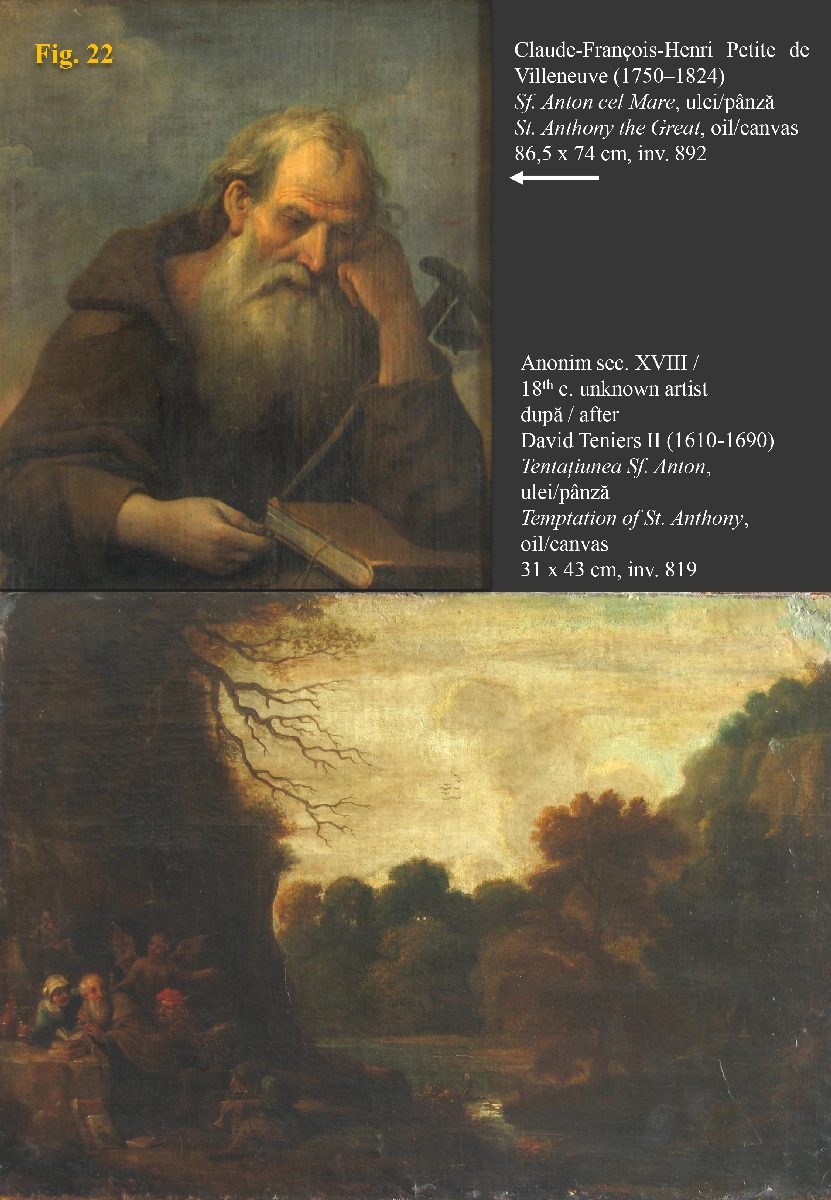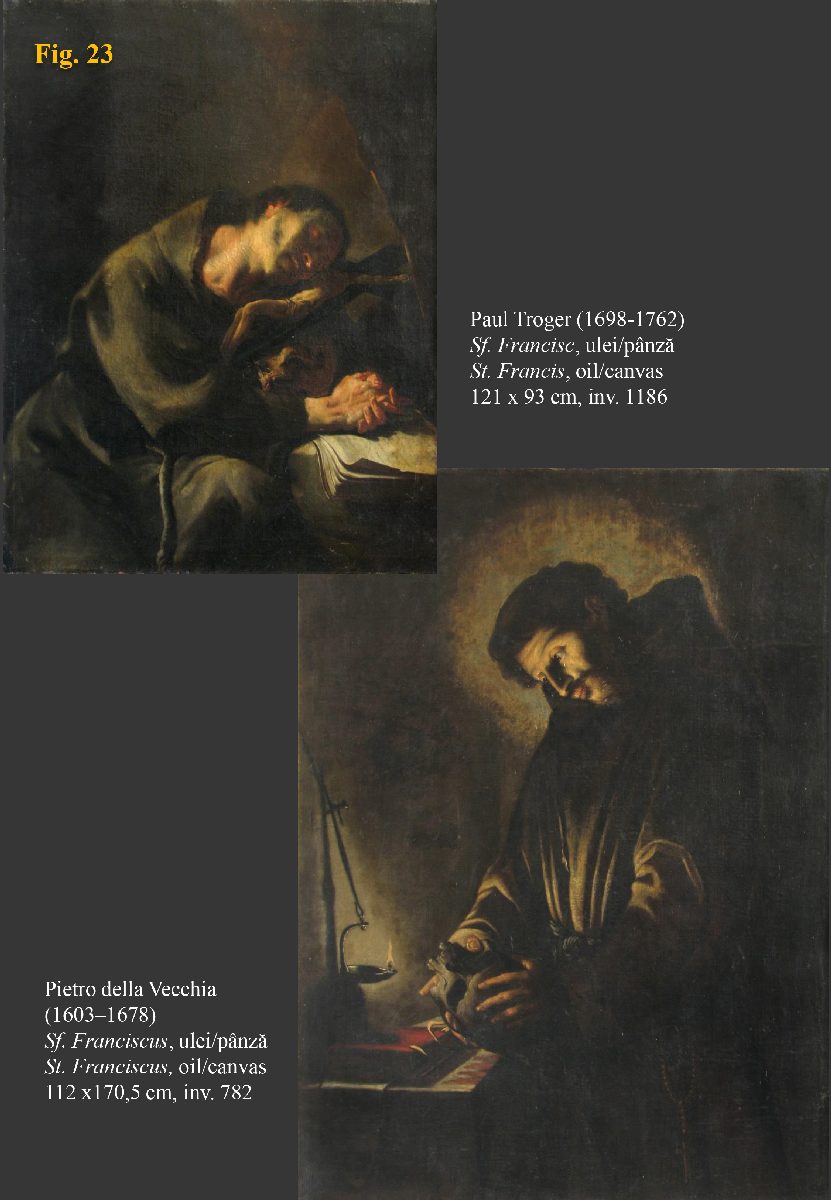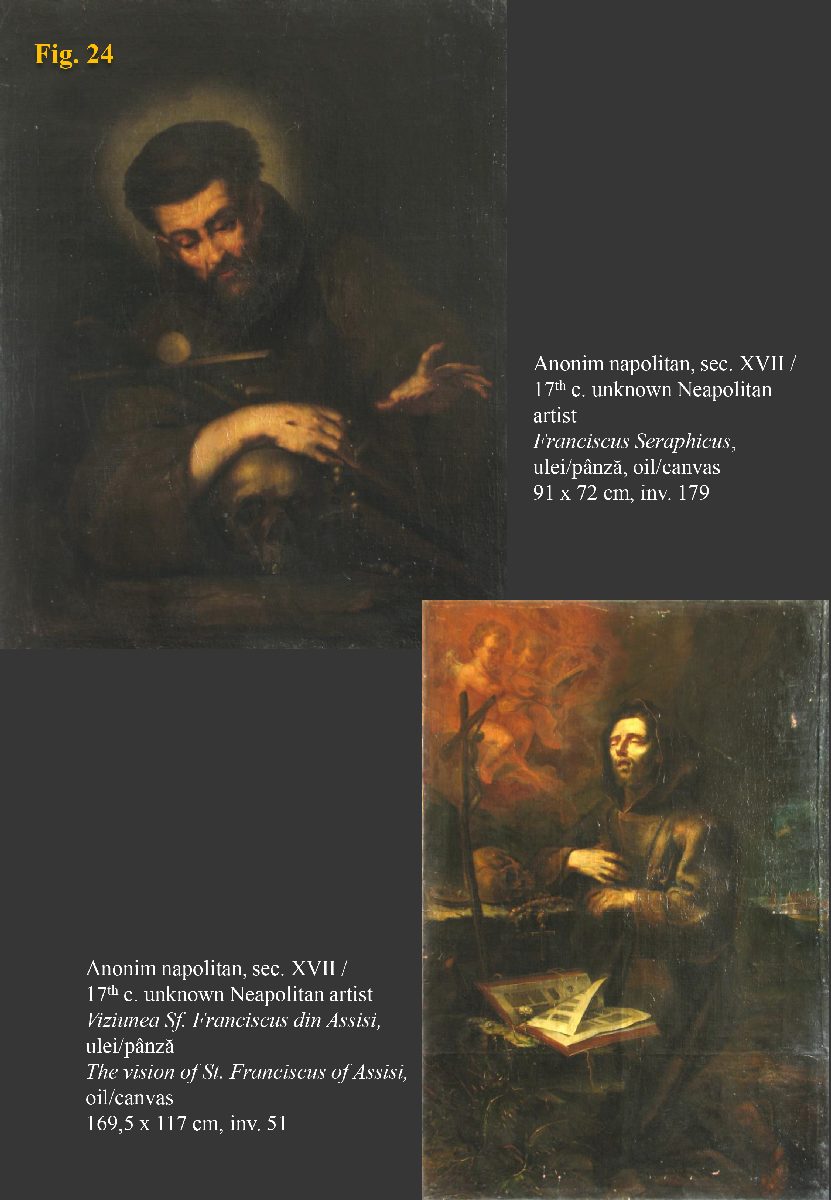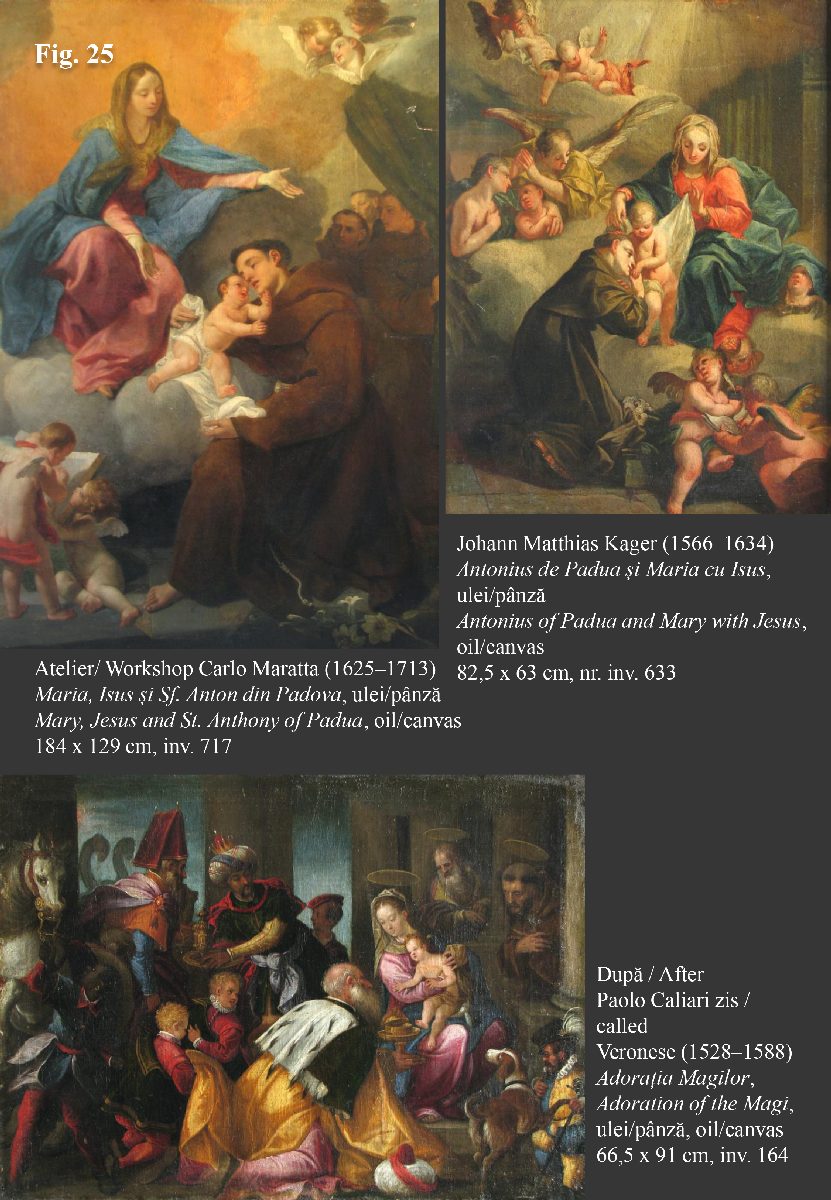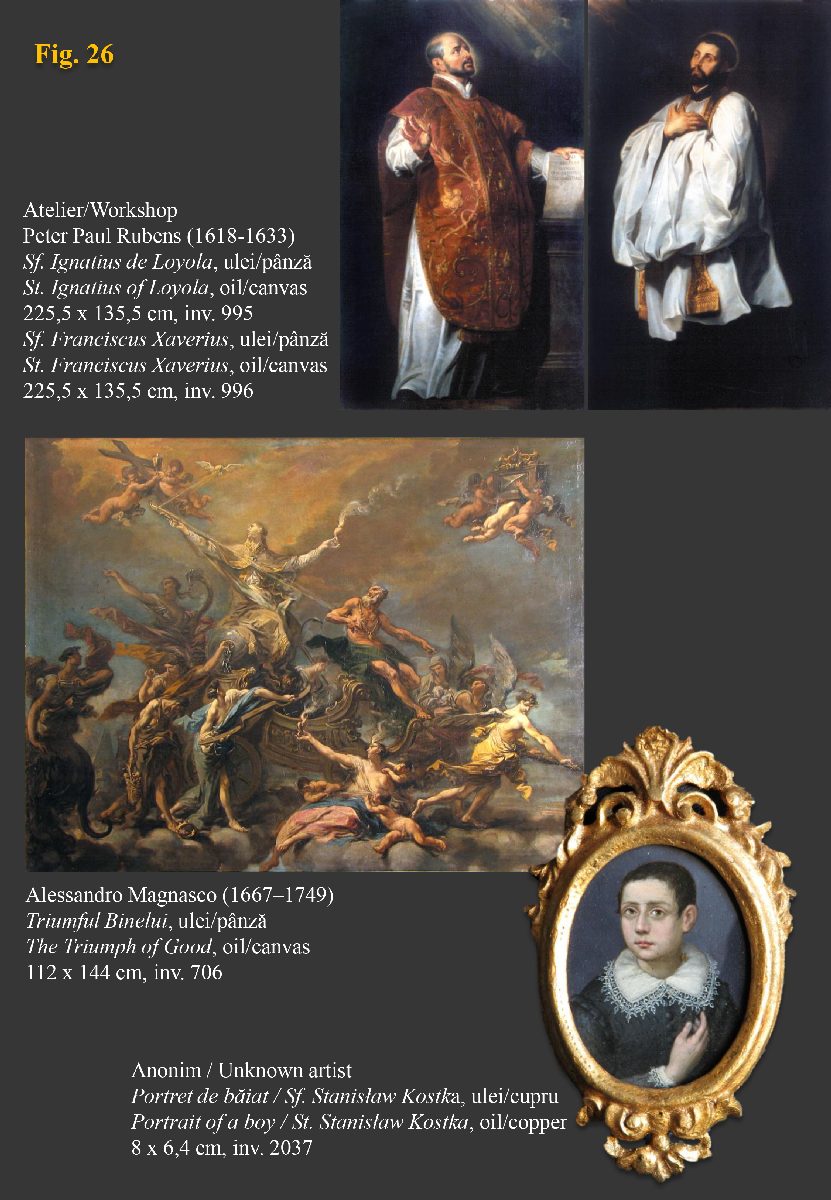Part 8: Monks
St. Anthony the Great (c. 251–356), one of the Desert Fathers (Fig. 22) and one of the first hermits (ca. 270), became a model for monks (especially hermits). Accounts of his temptations by the devil inspired numerous works of art, including scenes painted by David Teniers the Younger (1610–1690). According to A. Sonoc, the Temptation of St. Anthony from the museum collection, although purchased as a work by David Teniers the Younger, is the product of a forger from the first half of the 18th c., having vague compositional affinities with two original works (located at the Koninklijk Museum voor Schone Kunsten in Antwerp, inv. 859 and the Rose-Marie and Eijk van Otterloo collection, dated ca. 1650), from which he takes a small number of characters.
Regarding St. Anthony the Great, by Claude-François-Henri Petite de Villeneuve (1750–1824), A. Sonoc analyzed the identity of the character in relation to its attributes (the T-shaped staff with the bell), corrected the identity of the painter (wrongly registered, since the 19th century, as Jean-Baptiste-Marie Pierre, although the painting was visibly signed only C. Petit) and historically contextualized the painting in regards to the Restoration period.
Founded in 1209 by St. Franciscus of Assisi (Fig. 23 and 24), having a pronounced missionary description, the Franciscan Order is still one of the most important Catholic monastic ones. In the museum's collection, in addition to a work by Paul Troger (inv. 1186), St. Franciscus of Assisi is represented in a work by Pietro della Vecchia (inv. 782). A. Sonoc indicated the distinction between Pietro della Vecchia (1603–1678), from a famous Venetian family, and the Benedictine Pietro Vecchia (1628–1695), bishop of Andria (1690–1691) and then of Molfetta (1691–1695) – as the work was previously recorded. Also, Sonoc dates it back to approx. 1630, since among the painter's religious works, which have been dated and are comparable, for now there is only St. Dominic and the Devil from the Indianapolis Museum of Art in Newfields (oil on canvas, 43.02 x 127.31 cm, no. 57,133), dated approx. 1630. The museum collection also includes a work previously considered a copy after Agostino Carracci and reattributed by Raluca-Georgiana Cobuz to an anonymous Neapolitan from the first half of the 18th c. (inv. 179) and a work previously considered to be a copy after Guido Reni, reattributed by R. Cobuz to an anonymous Neapolitan from the middle of the 18th c. (inv. 51), at the same time being identified the church represented in the lower right as the very church dedicated to the saint in Assisi. St. Antonius of Padua (1195–1231) was a Franciscan (Fig. 25) from a wealthy family of Portuguese origin. He was noted for his impressive sermons and biblical knowledge, being canonized less than a year after his death. In 1946 Pope Pius XII proclaimed him a Doctor of the Church. In the work attributed to the workshop of Carlo Maratta (1625–1713), the Virgin Mary and the Child appear on a cloud. At St. Anthony's feet is a bouquet of lily flowers, a symbol of purity. According to A. Sonoc, the Virgin makes a broad gesture with her hands, attracting the attention of a group of three Franciscan brethren, who emerge from behind a curtain, which suggests that they are the patrons and, consequently, cannot be Observant Franciscans, but either Conventual Franciscans or Capuchins. The second work, painted by Johann Matthias Kager (1566–1634), represents a vision of the Blessed Virgin Mary and the Infant Jesus, on a cloud surrounded by angels, in the cloister of a monastery. In both compositions the saint is represented in the robes of a Franciscan, worshiping. In the painting Adoration of the Magi, currently considered a copy after Paolo Caliari called Veronese (1528–1588), St. Anthony of Padua (easily recognizable by the Franciscan monk's robes, tonsure, lily flowers in his hands and halo) is rendered in the portico a palace, as a spectator, next to St. Jerome (who holds a book in his hands). The work is also inspired by devotio moderna, as the scene presents the aspects of a 16th c. court (attires and etiquette). The presence of the two saints could indicate that they are the patrons of those who sponsored the work which previously was considered a bozzetto.
The Jesuit Order or the Society of Jesus, is a monastic order formed in the context of the Counter-Reformation, intended for missionary activity and education; in addition to the vows of chastity, obedience and poverty, it was also instituted an oath of obedience to the pope and engagement in his projects, thus being involved in secular actions, even of a political nature. Its main founders and, at the same time, the best-known representatives are St. Ignatius of Loyola (1491–1556) and St. Franciscus Xaverius (1506–1652), from the collection of Baron Samuel von Brukenthal (Fig. 26) coming their pendant portraits: St. Ignatius of Loyola (inv. 995) and St. Franciscus Xaverius (inv. 996), products of the workshop of Peter Paul Rubens (1618-1633). St. Ignatius of Loyola is also represented in the allegorical work The Triumph of Good, by Alessandro Magnasco (1667–1749), also known as the Apotheosis of St. Ignatius of Loyola. The composition represents him in liturgical vestments, holding in his left hand the symbol of the flaming heart of Jesus (allusion to religious fervor), seated on an earthly globe, in a chariot drawn by angels and surrounded by the personifications of the virtues (the 4 cardinal virtues of moral theology Catholic, i.e. wisdom, justice, courage and temperance and the 3 theological virtues, namely charity, hope and faith).
St. Stanisław Kostka (1550–1568) was born into a family of the high Polish aristocracy (Fig. 26) and was brought up strictly in the spirit of piety, modesty, and temperance. He studied at the Jesuit College in Vienna, showing great piety and, despite the aggression he suffered from his older brother Paweł and his tutor Jan Bilinski, he did not give up becoming a novice of the Society of Jesus; arriving with great difficulty in Dillingen and then seriously ill in Rome, he died during prayer, on the feast of the Assumption of the Blessed Virgin Mary (August 15, 1568). He was canonized in 1726 and is considered a protector of children and young people that found themselves in difficult times, also protecting against heart palpitations, fractures and serious illnesses.
He has as attributes the Jesuit vestments, the lily flower and the host and is especially popular in the Catholic communities of Poland (being one of the protectors of the state) and in its neighboring countries. St. Stanisław Kostka was identified by A. Sonoc in a miniature entitled Portrait of a Boy, attributed to an anonymous Dutchman from the 19th c., based on the physiognomic features reminiscent of the portrait made in 1567 by the Milanese Scipione Delfine (third decade of the 16th c. – 1590), the oldest portrait preserved to this day, and on the vestments of a Jesuit novice: a black vest with a collar and white lace cuff. The round figure, with close-cropped hair, straight eyebrows, large, brown, watery eyes, straight nose, small mouth, prominent chin, expresses suffering, sadness and compassion. The right hand is brought to the chest, with the fingers in a position similar to that of the blessing gesture in the Byzantine rite.
Click an image below to open it


